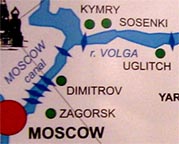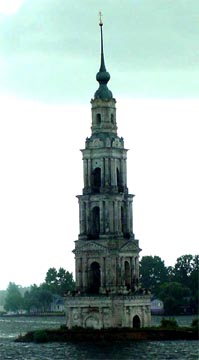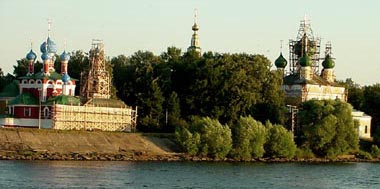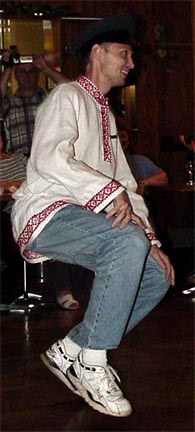Good Morning. This is the voice of Oleg on board the ship you are listening to.
The first morning on the canal was unforgetable as the ship glided quietly through the early morning mist as fishermen and campers rustled themselves into action.
The canal was built in the period from 1931 to 1937, during the most horrible years of Stalin leadership and is a unique masterpiece of civil engineering. It is said the amount of soil excavated during its construction exceeds by far that of Panama and Suez canals. But what makes it really beautiful is a unique combination of architecture, natural landscapes and water.
It was an unforgettable experience. A mixture of beauty with a sense of the cruely the people suffered building it.
Soon we were approaching Lock #2 (#3 to #6 we had passed in the night) As to the figures on the lock towers, the book Russia by River states: on the left you have three rank-and-file Soviet workers; on the right the threesome is comprised of a Pilot, a soldier, and a border guard. Why? Why not. The net change in water level here was six meters.
Continuing along, a highlight was seeing the the Sestra River ("Sister River") cross the canal. What you say? Note that the river has been artificially diverted beneath the canal.
We would soon be leaving the canal to make a right turn into the Volga. Leaving our new friends waving to us from shore we passed a lighthouse and Lenin welcoming us to the Volga, and arrived where the Volga River is joined to the Moscow Canal by Lock #1.
Soon we passed the town of Dubna, known for its Atomic Energy Research Institute. This is what the Soviets called a "science town." It appears that science gets a lot of respect. Look at the size of the dachas.
Approaching the mouth of the Kashinka River and going under the Kashinskiy railroad bridge which carries St. Petersburg-Moscow trains across the Volga the river widens. The river was flooded to dam the river at the Uglich Hydroplant. The flooded belfry of Kalyazin stands in the water alone.. Erected in 1800 as part of the St. Nicholas Cathedral on Kalyazin's Market Square, the belfry formerly stood 70 meters high and was considered among the finest structures along the Volga. You were now sailing over Kalyazin's Market Square. The upper portion of the belfry has been planted on an earthen foundation to remind us of how things were.
Russia by River adds more to the story. Behind the belfry, around the mouth of the Zhabnya River, lies the town of Kalyazin, which suffered much the same fate as its belfry. The town sprung up around the Kalyazin Monastery, founded in the 15th century by Saint Makary on land donated by a converted feudal lord, Ivan Kolyaga. By the 16th century the monastery had become among the richest in Russia. Tsar Ivan IV (the Terrible) personally visiited and donated rare manuscripts to the monastery's library. In the 20th century Tsar Josef Stalin also visited-in the form of Soviet dynamite that blew up the place.
At the Mouth of the Puksha River sat the village of Priulky, featuring, a lovely five-domed church and continuing along the river we passed villages of Kotovo and Korozhechno
In late afternoon we entered the lock of the UgIich Hydroplant and passed through the triumphal arch, built to commemorate Victory over Germany. The lock, completed in 1940, has a level change of 11 meters.
The ship tied up beneath the high embankment of the ancient city of Uglich. After supper we had a walking tour to the Kremlin. The splendid Church of St. Dmitry on the Blood with its star-studded cupolas and the green-domed Transfiguration Cathedral awaited our inspection as did a myriad of entrepreneurs.
The town of Uglich dates from the 10th century. In the 16th century, Ivan the Terrible used Uglich as a base for attacks against the Tatars. After Ivan's death, his son Dmitry moved there with his mother and seven years later was murdered probably on order of Boris Gudunov. The town revolted, which led to its own massacre. This was the beginning of what is called the Time of Troubles. The Church of St. Dmitry on the Blood is named in honor of these events. The 5-domed church is Transfiguration Cathedral. The Kremlin wall is gone, providing an excellent view from the river.





Checkers played with Russian vodka and cognac. It was great fun! If I remember.